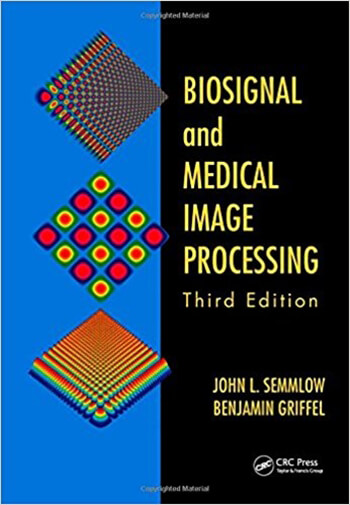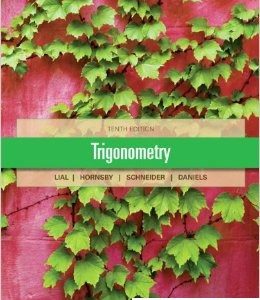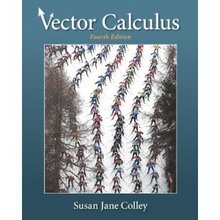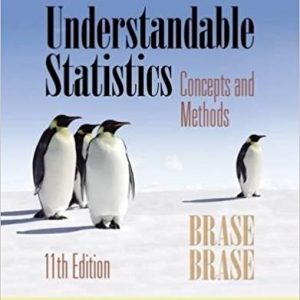Biosignal and Medical Image Processing 3rd Semmlow Solution Manual

Product details:
- ISBN-10 : 1466567368
- ISBN-13 : 978-1466567368
- Author: Semmlow
Written specifically for biomedical engineers, Biosignal and Medical Image Processing, Third Edition provides a complete set of signal and image processing tools, including diagnostic decision-making tools, and classification methods. Thoroughly revised and updated, it supplies important new material on nonlinear methods for describing and classifying signals, including entropy-based methods and scaling methods. A full set of PowerPoint slides covering the material in each chapter and problem solutions is available to instructors for download.
Table contents:
- Chapter 1 Introduction
- 1.1 Biosignals
- 1.2 Biosignal Measurement Systems
- 1.3 Transducers
- 1.4 Amplifier/Detector
- 1.5 Analog Signal Processing and Filters
- 1.5.1 Filter Types
- 1.5.2 Filter Bandwidth
- 1.5.3 Filter Order
- 1.5.4 Filter Initial Sharpness
- 1.6 ADC Conversion
- 1.6.1 Amplitude Slicing
- 1.6.2 Time Slicing
- 1.6.3 Edge Effects
- 1.6.4 Buffering and Real-Time Data Processing
- 1.7 Data Banks
- 1.8 Summary
- Problems
- Chapter 2 Biosignal Measurements, Noise, and Analysis
- 2.1 Biosignals
- 2.1.1 Signal Encoding
- 2.1.2 Signal Linearity, Time Invariance, Causality
- 2.1.2.1 Superposition
- 2.1.3 Signal Basic Measurements
- 2.1.4 Decibels
- 2.1.5 Signal-to-Noise Ratio
- 2.2 Noise
- 2.2.1 Noise Sources
- 2.2.2 Noise Properties: Distribution Functions
- 2.2.3 Electronic Noise
- 2.3 Signal Analysis: Data Functions and Transforms
- 2.3.1 Comparing Waveforms
- 2.3.1.1 Vector Representation
- 2.3.1.2 Orthogonality
- 2.3.1.3 Basis Functions
- 2.3.2 Correlation-Based Analyses
- 2.3.2.1 Correlation and Covariance
- 2.3.2.2 Matrix of Correlations
- 2.3.2.3 Cross-Correlation
- 2.3.2.4 Autocorrelation
- 2.3.2.5 Autocovariance and Cross-Covariance
- 2.3.3 Convolution and the Impulse Response
- 2.4 Summary
- Problems
- Chapter 3 Spectral Analysis: Classical Methods
- 3.1 Introduction
- 3.2 Fourier Series Analysis
- 3.2.1 Periodic Functions
- 3.2.1.1 Symmetry
- 3.2.2 Complex Representation
- 3.2.3 Data Length and Spectral Resolution
- 3.2.3.1 Aperiodic Functions
- 3.2.4 Window Functions: Data Truncation
- 3.3 Power Spectrum
- 3.4 Spectral Averaging: Welch’s Method
- 3.5 Summary
- Problems
- Chapter 4 Noise Reduction and Digital Filters
- 4.1 Noise Reduction
- 4.2 Noise Reduction through Ensemble Averaging
- 4.3 Z-Transform
- 4.3.1 Digital Transfer Function
- 4.4 Finite Impulse Response Filters
- 4.4.1 FIR Filter Design and Implementation
- 4.4.2 Derivative Filters: Two-Point Central Difference Algorithm
- 4.4.2.1 Determining Cutoff Frequency and Skip Factor
- 4.4.3 FIR Filter Design Using MATLAB
- 4.5 Infinite Impulse Response Filters
- 4.5.1 IIR Filter Implementation
- 4.5.2 Designing IIR Filters with MATLAB
- 4.6 Summary
- Problems
- Chapter 5 Modern Spectral Analysis: The Search for Narrowband Signals
- 5.1 Parametric Methods
- 5.1.1 Model Type and Model Order
- 5.1.2 Autoregressive Model
- 5.1.3 Yule–Walker Equations for the AR Model
- 5.2 Nonparametric Analysis: Eigenanalysis Frequency Estimation
- 5.2.1 Eigenvalue Decomposition Methods
- 5.2.2 Determining Signal Subspace and Noise Subspace Dimensions
- 5.2.3 MATLAB Implementation
- 5.3 Summary
- Problems
- Chapter 6 Time–Frequency Analysis
- 6.1 Basic Approaches
- 6.2 The Short-Term Fourier Transform: The Spectrogram
- 6.2.1 MATLAB Implementation of the STFT
- 6.3 The Wigner–Ville Distribution: A Special Case of Cohen’s Class
- 6.3.1 The Instantaneous Autocorrelation Function
- 6.3.2 Time–Frequency Distributions
- 6.3.3 The Analytic Signal
- 6.4 Cohen’s Class Distributions
- 6.4.1 The Choi–Williams Distribution
- 6.5 Summary
- Problems
- Chapter 7 Wavelet Analysis
- 7.1 Introduction
- 7.2 Continuous Wavelet Transform
- 7.2.1 Wavelet Time–Frequency Characteristics
- 7.2.2 MATLAB Implementation
- 7.3 Discrete Wavelet Transform
- 7.3.1 Filter Banks
- 7.3.1.1 Relationship between Analytical Expressions and Filter Banks
- 7.3.2 MATLAB Implementation
- 7.3.2.1 Denoising
- 7.3.2.2 Discontinuity Detection
- 7.4 Feature Detection: Wavelet Packets
- 7.5 Summary
- Problems
- Chapter 8 Optimal and Adaptive Filters
- 8.1 Optimal Signal Processing: Wiener Filters
- 8.1.1 MATLAB Implementation
- 8.2 Adaptive Signal Processing
- 8.2.1 ALE and Adaptive Interference Suppression
- 8.2.2 Adaptive Noise Cancellation
- 8.2.3 MATLAB Implementation
- 8.3 Phase-Sensitive Detection
- 8.3.1 AM Modulation
- 8.3.2 Phase-Sensitive Detectors
- 8.3.3 MATLAB Implementation
- 8.4 Summary
- Problems
- Chapter 9 Multivariate Analyses: Principal Component Analysis and Independent Component Analysis
- 9.1 Introduction: Linear Transformations
- 9.2 Principal Component Analysis
- 9.2.1 Determination of Principal Components Using Singular-Value Decomposition
- 9.2.2 Order Selection: The Scree Plot
- 9.2.3 MATLAB Implementation
- 9.2.3.1 Data Rotation
- 9.2.4 PCA in MATLAB
- 9.3 Independent Component Analysis
- 9.3.1 MATLAB Implementation
- 9.4 Summary
- Problems
- Chapter 10 Chaos and Nonlinear Dynamics
- 10.1 Nonlinear Systems
- 10.1.1 Chaotic Systems
- 10.1.2 Types of Systems
- 10.1.3 Types of Noise
- 10.1.4 Chaotic Systems and Signals
- 10.2 Phase Space
- 10.2.1 Iterated Maps
- 10.2.2 The Hénon Map
- 10.2.3 Delay Space Embedding
- 10.2.4 The Lorenz Attractor
- 10.3 Estimating the Embedding Parameters
- 10.3.1 Estimation of the Embedding Dimension Using Nearest Neighbors
- 10.3.2 Embedding Dimension: SVD
- 10.4 Quantifying Trajectories in Phase Space: The Lyapunov Exponent
- 10.4.1 Goodness of Fit of a Linear Curve
- 10.4.2 Methods of Determining the Lyapunov Exponent
- 10.4.3 Estimating the Lyapunov Exponent Using Multiple Trajectories
- 10.5 Nonlinear Analysis: The Correlation Dimension
- 10.5.1 Fractal Objects
- 10.5.2 The Correlation Sum
- 10.6 Tests for Nonlinearity: Surrogate Data Analysis
- 10.7 Summary Exercises
- Chapter 11 Nonlinearity Detection: Information-Based Methods
- 11.1 Information and Regularity
- 11.1.1 Shannon’s Entropy Formulation
- 11.2 Mutual Information Function
- 11.2.1 Automutual Information Function
- 11.3 Spectral Entropy
- 11.4 Phase-Space-Based Entropy Methods
- 11.4.1 Approximate Entropy
- 11.4.2 Sample Entropy
- 11.4.3 Coarse Graining
- 11.5 Detrended Fluctuation Analysis
- 11.6 Summary
- Problems
- Chapter 12 Fundamentals of Image Processing: The MATLAB Image Processing Toolbox
- 12.1 Image-Processing Basics: MATLAB Image Formats
- 12.1.1 General Image Formats: Image Array Indexing
- 12.1.2 Image Classes: Intensity Coding Schemes
- 12.1.3 Data Formats
- 12.1.4 Data Conversions
- 12.2 Image Display
- 12.3 Image Storage and Retrieval
- 12.4 Basic Arithmetic Operations
- 12.5 Block-Processing Operations
- 12.5.1 Sliding Neighborhood Operations
- 12.5.2 Distinct Block Operations
- 12.6 Summary
- Problems
- Chapter 13 Image Processing: Filters, Transformations, and Registration
- 13.1 Two-Dimensional Fourier Transform
- 13.1.1 MATLAB Implementation
- 13.2 Linear Filtering
- 13.2.1 MATLAB Implementation
- 13.2.2 Filter Design
- 13.3 Spatial Transformations
- 13.3.1 Affine Transformations
- 13.3.1.1 General Affine Transformations
- 13.3.2 Projective Transformations
- 13.4 Image Registration
- 13.4.1 Unaided Image Registration
- 13.4.2 Interactive Image Registration
- 13.5 Summary
- Problems
- Chapter 14 Image Segmentation
- 14.1 Introduction
- 14.2 Pixel-Based Methods
- 14.2.1 Threshold Level Adjustment
- 14.2.2 MATLAB Implementation
- 14.3 Continuity-Based Methods
- 14.3.1 MATLAB Implementation
- 14.4 Multithresholding
- 14.5 Morphological Operations
- 14.5.1 MATLAB Implementation
- 14.6 Edge-Based Segmentation
- 14.6.1 Hough Transform
- 14.6.2 MATLAB Implementation
- 14.7 Summary
- Problems
- Chapter 15 Image Acquisition and Reconstruction
- 15.1 Imaging Modalities
- 15.2 CT, PET, and SPECT
- 15.2.1 Radon Transform
- 15.2.2 Filtered Back Projection
- 15.2.3 Fan Beam Geometry
- 15.2.4 MATLAB Implementation of the Forward and Inverse Radon Transforms: Parallel Beam Geometry
- 15.2.5 MATLAB Implementation of the Forward and Inverse Radon Transforms: Fan Beam Geometry
- 15.3 Magnetic Resonance Imaging
- 15.3.1 Magnetic Gradients
- 15.3.2 Data Acquisition: Pulse Sequences
- 15.4 Functional MRI
- 15.4.1 fMRI Implementation in MATLAB
- 15.4.2 Principal Component and ICA
- 15.5 Summary
- Problems
- Chapter 16 Classification I: Linear Discriminant Analysis and Support Vector Machines
- 16.1 Introduction
- 16.1.1 Classifier Design: Machine Capacity
- 16.2 Linear Discriminators
- 16.3 Evaluating Classifier Performance
- 16.4 Higher Dimensions: Kernel Machines
- 16.5 Support Vector Machines
- 16.5.1 MATLAB Implementation
- 16.6 Machine Capacity: Overfitting or “Less Is More”
- 16.7 Extending the Number of Variables and Classes
- 16.8 Cluster Analysis
- 16.8.1 K-Nearest Neighbor Classifier
- 16.8.2 k-Means Clustering Classifier
- 16.9 Summary
- Problems
- Chapter 17 Classification II: Adaptive Neural Nets
- 17.1 Introduction
- 17.1.1 Neuron Models
- 17.2 Training the McCullough–Pitts Neuron
- 17.3 The Gradient Decent Method or Delta Rule
- 17.4 Two-Layer Nets: Back Projection
- 17.5 Three-Layer Nets
- 17.6 Training Strategies
- 17.6.1 Stopping Criteria: Cross-Validation
- 17.6.2 Momentum
- 17.7 Multiple Classifications
- 17.8 Multiple Input Variables
- 17.9 Summary
- Problems
- Appendix A: Numerical Integration in MATLAB
- Appendix B: Useful MATLAB Functions
- Bibliography
- Index
People also search:
biosignal and medical image processing 3rd edition pdf
medical image processing companies
what is the most common form of medical imaging
biosignal and medical image processing pdf
|
image processing in biomedical engineering |





